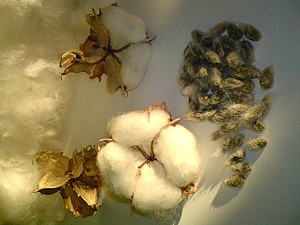
As I’ve studied medicinal plants, one intriguing question keeps cropping up – what is the biological rationale for plants investing in several classes of structurally varied plant secondary metabolites?. Certainly this question drives a number of researchers in the field of plant chemical ecology. Edwards et al (2008) provided some striking evidence from their study of bacteria resistant cotton (Gossypium hirsutum).
They detected flavonoid pigments, chrysanthemin and isoquercitin, at unusually high levels in epidermal tissue of young leaves in response to Xanthomonas infection. These cells clustered around infected cells that had died because of the plant’s hypersensitive resistance response.
A very different chemical, a sesquiterpene, 2,7-dihyroxycadalene, acted as a light activated phytoalexin, destroying both bacteria and the infected plant cell. So what were the flavanoids doing to help out? The presence of the flavanoids in surrounding cells appeared to filter sunlight, limiting the generation of free radicals resulting from light activation of 2,7-dihyroxycadaline. How’s that for compartmentalizing your response to friends and enemies?
